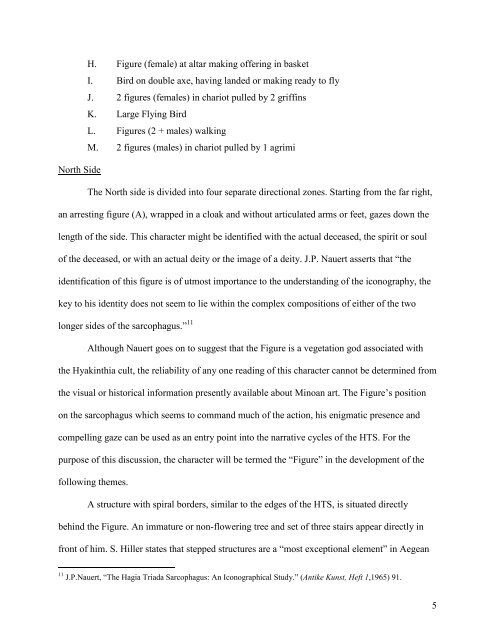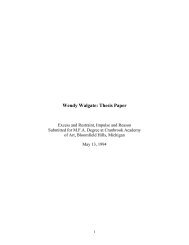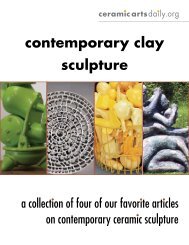Narrative Cycles on the Hagia Triada Sarcophagus - Wendy Walgate
Narrative Cycles on the Hagia Triada Sarcophagus - Wendy Walgate
Narrative Cycles on the Hagia Triada Sarcophagus - Wendy Walgate
- No tags were found...
Create successful ePaper yourself
Turn your PDF publications into a flip-book with our unique Google optimized e-Paper software.
H. Figure (female) at altar making offering in basketI. Bird <strong>on</strong> double axe, having landed or making ready to flyJ. 2 figures (females) in chariot pulled by 2 griffinsK. Large Flying BirdL. Figures (2 + males) walkingM. 2 figures (males) in chariot pulled by 1 agrimiNorth SideThe North side is divided into four separate directi<strong>on</strong>al z<strong>on</strong>es. Starting from <strong>the</strong> far right,an arresting figure (A), wrapped in a cloak and without articulated arms or feet, gazes down <strong>the</strong>length of <strong>the</strong> side. This character might be identified with <strong>the</strong> actual deceased, <strong>the</strong> spirit or soulof <strong>the</strong> deceased, or with an actual deity or <strong>the</strong> image of a deity. J.P. Nauert asserts that “<strong>the</strong>identificati<strong>on</strong> of this figure is of utmost importance to <strong>the</strong> understanding of <strong>the</strong> ic<strong>on</strong>ography, <strong>the</strong>key to his identity does not seem to lie within <strong>the</strong> complex compositi<strong>on</strong>s of ei<strong>the</strong>r of <strong>the</strong> twol<strong>on</strong>ger sides of <strong>the</strong> sarcophagus.” 11Although Nauert goes <strong>on</strong> to suggest that <strong>the</strong> Figure is a vegetati<strong>on</strong> god associated with<strong>the</strong> Hyakinthia cult, <strong>the</strong> reliability of any <strong>on</strong>e reading of this character cannot be determined from<strong>the</strong> visual or historical informati<strong>on</strong> presently available about Minoan art. The Figure’s positi<strong>on</strong><strong>on</strong> <strong>the</strong> sarcophagus which seems to command much of <strong>the</strong> acti<strong>on</strong>, his enigmatic presence andcompelling gaze can be used as an entry point into <strong>the</strong> narrative cycles of <strong>the</strong> HTS. For <strong>the</strong>purpose of this discussi<strong>on</strong>, <strong>the</strong> character will be termed <strong>the</strong> “Figure” in <strong>the</strong> development of <strong>the</strong>following <strong>the</strong>mes.A structure with spiral borders, similar to <strong>the</strong> edges of <strong>the</strong> HTS, is situated directlybehind <strong>the</strong> Figure. An immature or n<strong>on</strong>-flowering tree and set of three stairs appear directly infr<strong>on</strong>t of him. S. Hiller states that stepped structures are a “most excepti<strong>on</strong>al element” in Aegean11 J.P.Nauert, “The <strong>Hagia</strong> <strong>Triada</strong> <strong>Sarcophagus</strong>: An Ic<strong>on</strong>ographical Study.” (Antike Kunst, Heft 1,1965) 91.5





